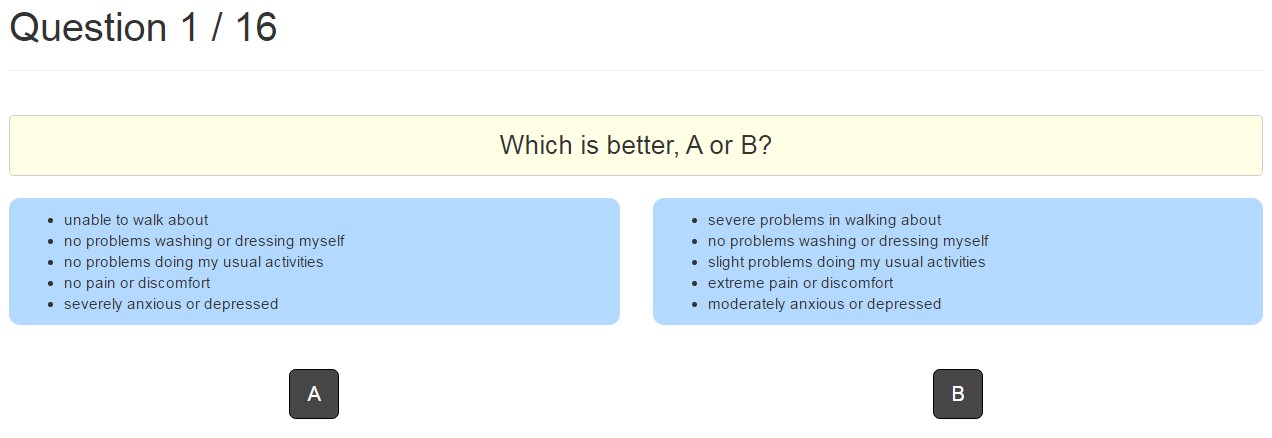Sign up to our newsletter Subscribe
Analysing Global Immunisation Expenditure

Sign up to our newsletter Subscribe


Recently published in the European Journal of Health Economics is a paper on valuing health states ‘in context’ using a discrete choice experiment. In health state valuation studies, health states are typically presented as a series of sentences, each describing…

Recently published in the European Journal of Health Economics is a paper on valuing health states ‘in context’ using a discrete choice experiment.
In health state valuation studies, health states are typically presented as a series of sentences, each describing a health dimension and severity ‘level’. Differences between the severity levels can be subtle, and semantic confusion about which is ‘worse’ can lead to logically inconsistent valuation data. This conventional way of presenting health states, in the context of a discrete choice experiment, is shown in Figure 1.
Recently published in the European Journal of Health Economics is a paper examining the impact of changing the way health states are presented in valuation studies, using the EQ-5D-5L – a patient-reported outcome (PRO) measure – as an example. The paper is authored by OHE’s Amanda Cole, Koonal Shah, Yan Feng and Nancy Devlin, in collaboration with Brendan Mulhern of the University of Technology Sydney.
 Figure 1. Standard presentation of health states in EQ-5D-5L valuation studies
Figure 1. Standard presentation of health states in EQ-5D-5L valuation studies
An online two-arm discrete choice experiment was conducted, with respondents in the test (context) arm seeing health states in the ‘context’ of the entire EQ-5D-5L descriptive system – as shown in Figure 2. The intention was to mimic the way in which patients see these health states when self-reporting their own health. This ensures that the health state being valued is as similar as possible to the one that is being described.
 Figure 2. Presentation of health states in the test (context) arm
Figure 2. Presentation of health states in the test (context) arm
The results show that presenting health states ‘in context’ can significantly reduce the selection of logically dominated health states. Comparing conditional logit modelling results, coefficients are ordered as expected in both arms, but the magnitude of decrements between levels is larger in the test arm. The authors conclude state health state presentation is a key consideration in the design of valuation studies.
This suggests that presenting PRO health states ‘in context’ may provide a way of helping respondents more readily to differentiate between the pairs of health states they are being asked to value in discrete choice experiments. The new approach to presenting health states could arguably offer even more advantage in time trade-off studies, where health states are presented one at a time. We hope to explore this in further research.
Cole, A., Shah, K., Mulhern, B., Feng, Y. and Devlin, N., 2017. Valuing EQ-5D-5L health states ‘in context’ using a discrete choice experiment. European Journal of Health Economics. DOI: 10.1007/s10198-017-0905-7
Earlier versions were presented the 2016 EuroQol Plenary Meeting and the 2016 ISPOR European Congress.
Related publications authored by OHE researchers:
An error has occurred, please try again later.
This website uses cookies so that we can provide you with the best user experience possible. Cookie information is stored in your browser and performs functions such as recognising you when you return to our website and helping our team to understand which sections of the website you find most interesting and useful.
Strictly Necessary Cookie should be enabled at all times so that we can save your preferences for cookie settings.
If you disable this cookie, we will not be able to save your preferences. This means that every time you visit this website you will need to enable or disable cookies again.
This website uses Google Analytics to collect anonymous information such as the number of visitors to the site, and the most popular pages.
Keeping this cookie enabled helps us to improve our website.
Please enable Strictly Necessary Cookies first so that we can save your preferences!